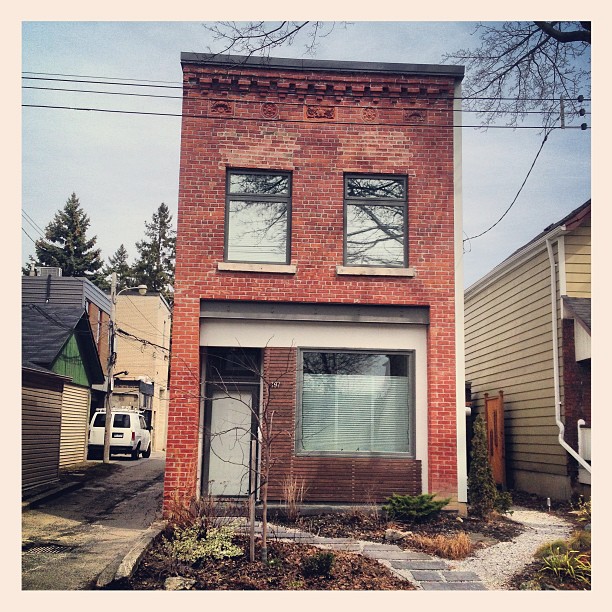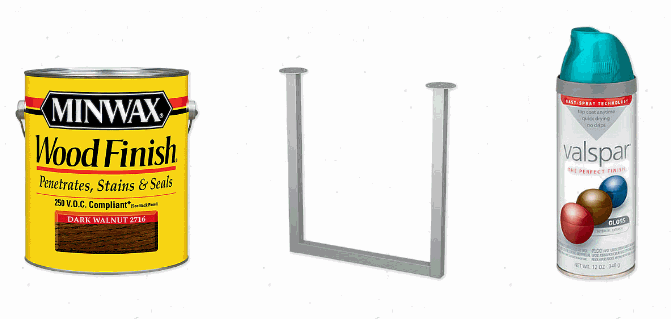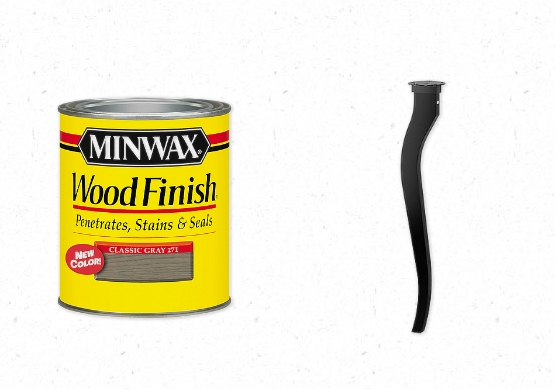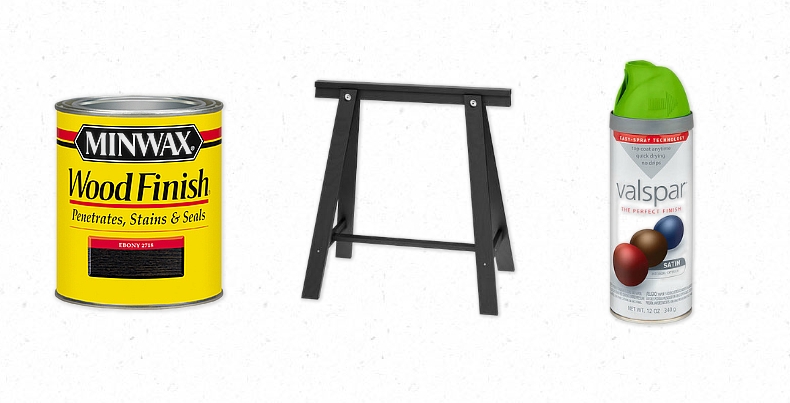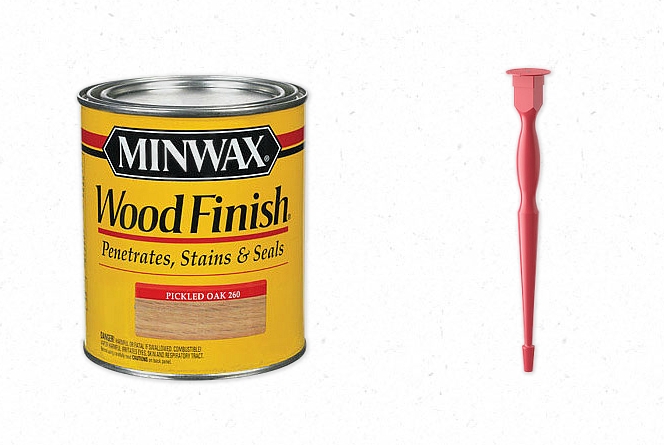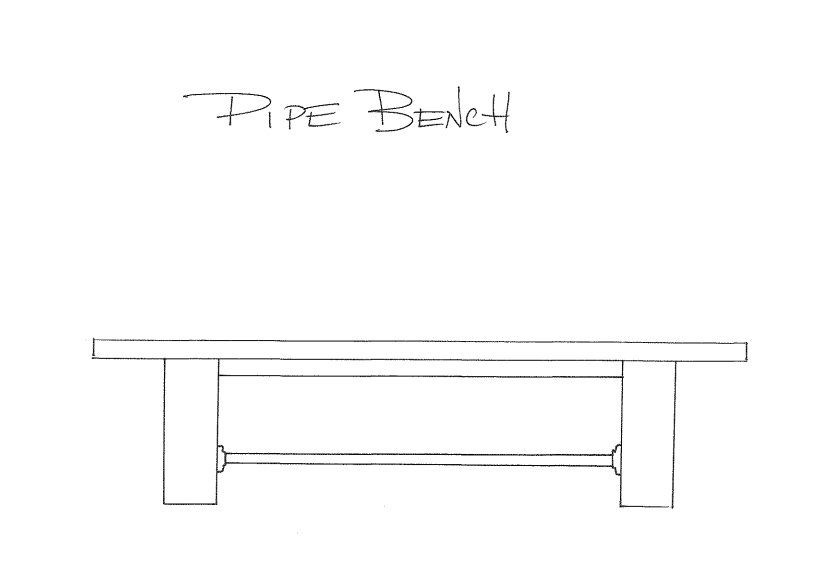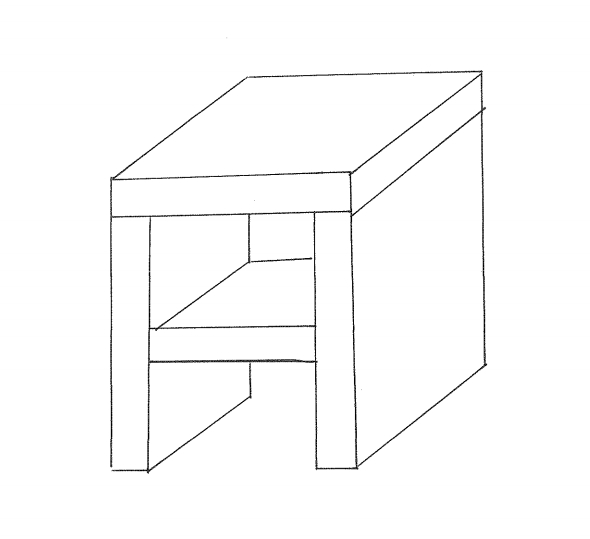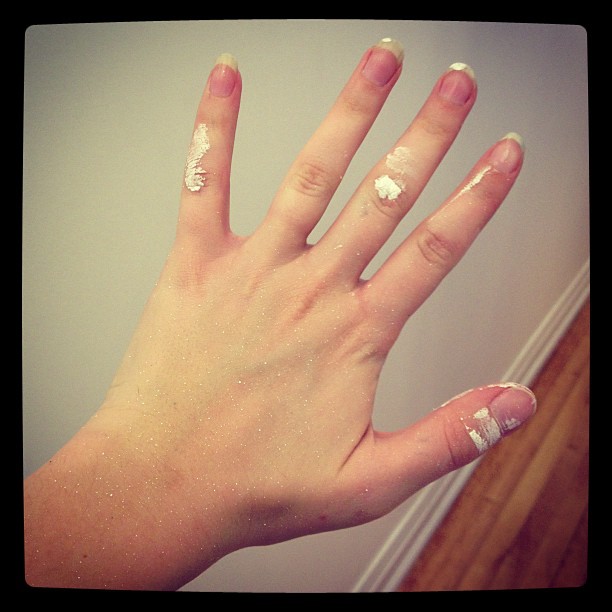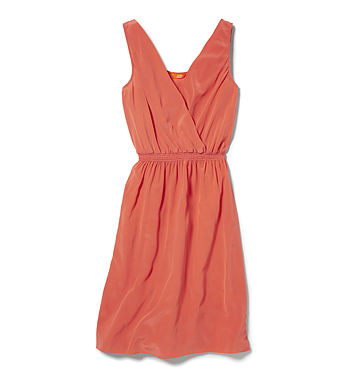We live in a converted storefront. To non city dwellers, living in an old store may sound a bit odd. However, there are quite a few converted storefronts in our neighborhood, and in downtown Toronto in general.
Month: July 2013
Make Your Own Custom Table
I know you’re probably all “tabled-out” with my table talk last week, but I just wanted to give you all some ideas for creating your own dining table.
As you know, we made a new top for our pipe leg table. It was easy peasy. Three boards, some supports, sanding, staining and protecting and its as easy as pie. (Well maybe not pie. Pie is pretty hard to make.) So now I’ve convinced you to make your own table top, but what if pipe legs aren’t your thing… It’s too hipster for you, or too industrial, or not glam enough. So don’t worry, I got your back. I’m your girl.
This is what you need to do. Make the table top. Then pick your stain color and pick your legs. It’s like a choose your own adventure novel, but with FURNITURE!
I know, your mind is blow! (right? maybe? a little bit blown? a spark?)
PICK A STAIN:
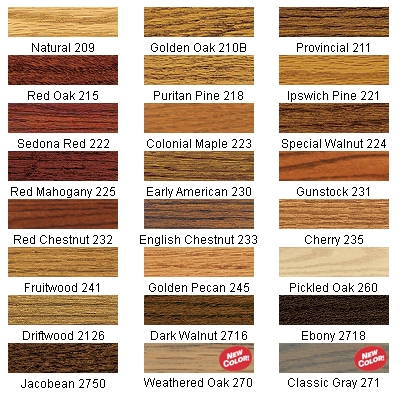
PICK A LEG:
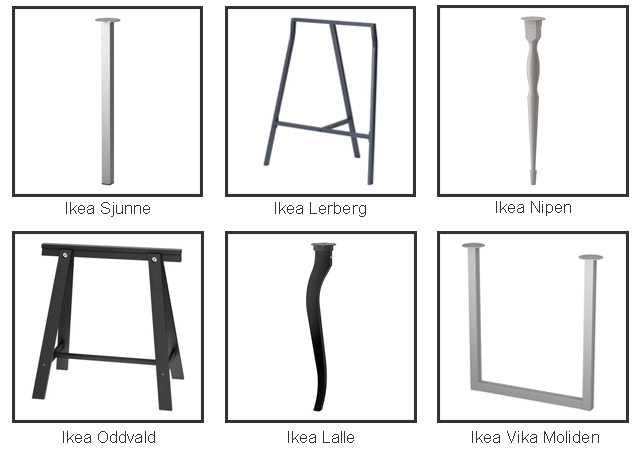

OPTIONAL: Pick a spray paint color to paint the legs:
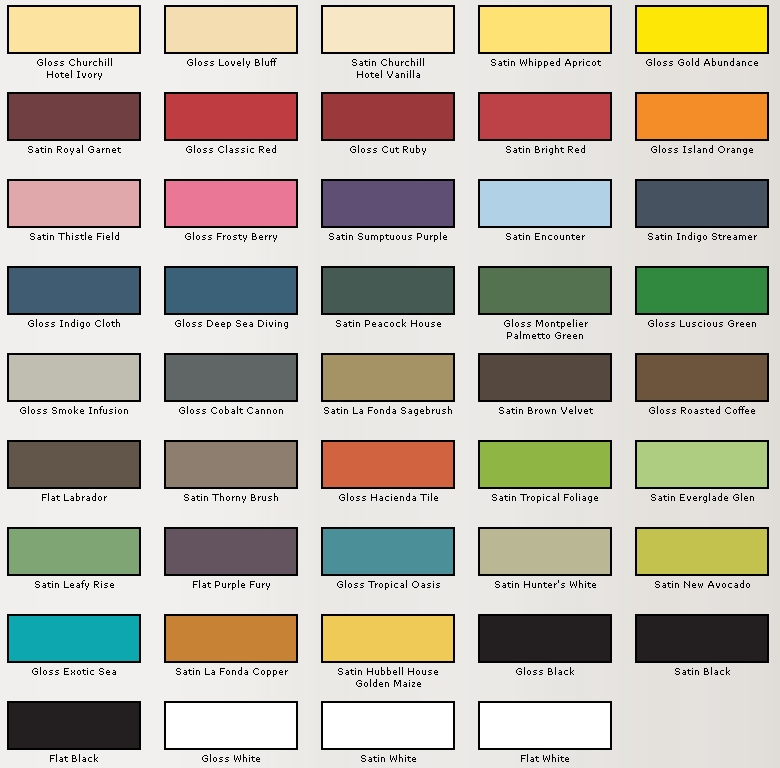
Here’s some of my ideas:
Dark Walnut top + Ikea Vika Moliden Underframe legs spray painted Exotic Sea.
Classic Gray top + Ikea black Lalle legs
Ebony top + Oddvald legs spray painted Troical Folliage
Minwax Pickled Oak + Red Nipen legs (which are more pink than red)
DIY TIP! If your idea of DIY & woodworking is watching HGTV in your PJ’s. Consider using a piece of prefab Ikea butcher block countertop as a table top. It comes in a 6’x3′ size (for $269) that would be perfect for a dining table!
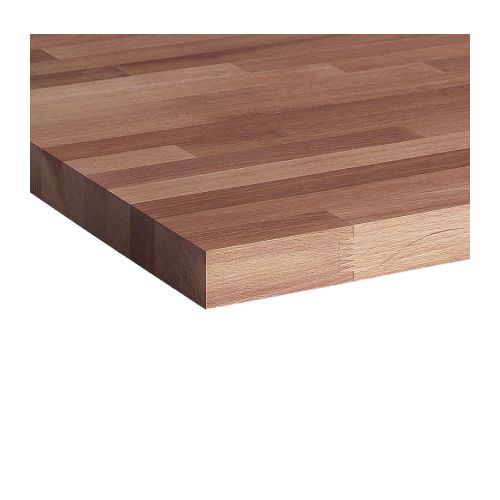
What options would you choose?!
Yet Another Bench
I know, I know, ANOTHER BENCH?! REALLY? Here’s the deal. We replaced the top of our pipe leg dining table, and our old bench was looking sad in comparison. It’s unfair to give one kid a present, and then stiff the other one. So Mr. Bench got an upgrade.
If you remember correctly, this is what the old bench (& table) looked like:

We salvaged the pipe stretcher from the old bench, and got to work making new legs & a top. We wanted something a bit more industrial looking. The old bench was fine, but a bit traditional. So we searched for inspiration and found this on Pinterest:
I loved the chunky legs and thought it had the perfect shape. So we set to building our own version with a pipe stretcher.
Buy List:
1 – 2×12 x 6′ piece of kiln dried pine (same as our table)
2 – pine 2×2’s @ 8′ for aprons
2 – pine 2×4’s @ 8′ for the legs (make sure these are square edged 2×4’s, not rounded ones like you use for framing)
3/4″ dowel
Wood Glue
4′ pre-cut piece of 3/4″ gas line pipe (threaded on both ends)
2 – 3/4″ pipe floor flanges
2 1/2″ pocket screws
Cut List:
1 – 2×12 at 68″ (bench top)
2 – 2×2 at 48 5/8″ (aprons)
10 – 2×4 at 16 1/2″ (legs) if you can, set yourself a jig on your saw to make sure all the pieces are cut exactly the same size
First up, glue 5 2×4’s together with wood glue and clamps making one great big 4×10, repeat with the other 5 2×4’s (if you don’t have enough clamps, do one leg, then let it dry for a day, unclamp and do the other leg.)

To make sure those legs aren’t gonna move, we also strengthened them with dowels (and a few screws). We liked the way the exposed dowels looked on Daniel & Adelle’s table, so we opted for that route. After the legs have dried, mark 3″ up from the bottom of the leg on one end and mark the center of the board. Then drill a 3/4″ hole with a spade bit about half way through your leg. Ideally it would go all the way through, but to do that nicely (without any tear out) and straight you really need a drill press (which we dont have!). So we opted to do a dowel from each end.

After your hole is drilled, cut a piece of dowel a bit longer than your hole, glue & tap in place. Repeat for all the other sides of both legs and let dry.

To strengthen the top of the legs we used a 3″ counter sunk screw from either end. We pre-drilled the holes with a 3/8″ drill bit, inserted the screws, then filled the hole with a wood plug & some glue. If you must use screws on a project, using wood plugs will make them a lot less glaringly obvious.

Once all the glue has dried (another day) you can cut the dowels close to flush using a coping saw, chisel, hand saw, Dremel, or oscillating multi-tool.
Now it is time to make a few pocket holes for attaching the legs to the top. We put three holes in each leg (kreg pocket hole jig set to 1 1/2″ thick material).
Time to sand. I always find that it is MUCH easier to sand pieces like legs before installing them. As we needed to sand down the exposed dowels, we started sanding with 80 grit until the dowels were flush, then switched to 100, then 150 and finally 220 grit.
The apron pieces got 2 pocket holes drilled in each end (to attach to the legs) and a good sand as well.
Next up, attach the flanges to either end of the pipe and attach the pipe stretcher to the legs with screws. We used a scrap 2×4 to set the flanges up from the bottom of the legs.

Next up, attaching the legs to the table and the aprons. Flip the bench top upside down and use it as a work table to attach the aprons. The aprons will give the bench even more strength, and stop it from wanting to shift sideways. Once the aprons are attached to the legs, center the legs on the bench top, and attach the legs with the pocket holes you drilled earlier.

Put in a few 2 1/2″ screws through the aprons into the top, and fill the Kreg holes with pocket hole wood plugs and glue.
Time to head back outside, give the top a sand, and an overall finish sand to the rest of the bench.


A coat of wood conditioner, two coats of Varathane Chocolate stain, and three coats of polyurethane later and this is what we’ve got. (check out my post on finishing wood here.)
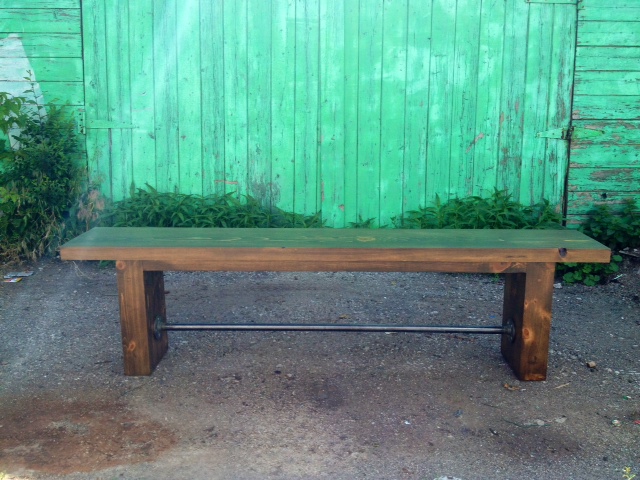
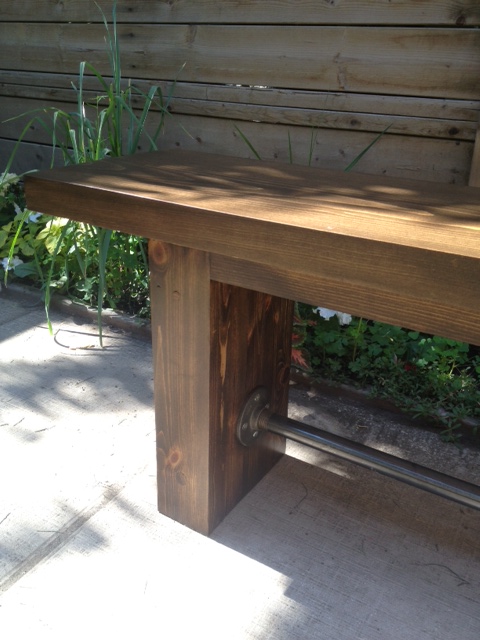

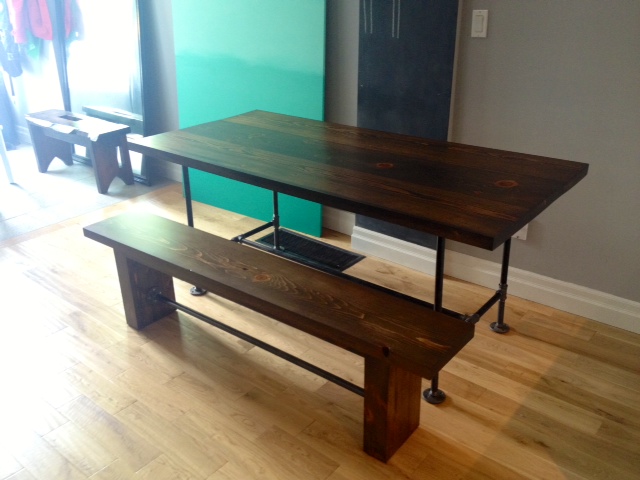
SOURCE LIST:
Materials & Cut List:
(see above) – Wood from Downtown Lumber
Stain – Varathane Chocolate
Polyurethane – Minwax Oil Modified in Satin
Tools Used:
Miter saw
Drill
Kreg Jig
Orbital sander
Measuring Tape
Finishing Supplies
Difficulty Level (on a scale of 1-5):
Total Cost: $60 (for the new wood, we already owned the pipe, stain & poly)
Quick & Dirty Outdoor Table
We got home from a week vacation in Vegas to find that our house hadn’t floated away in the Toronto Floods, and that our garden had doubled in size because of said rain. Win win. We also came home to a heat wave. You’d think I would be prepared for the heat after staying a week in the desert. No siree. Vegas heat = dry and wonderful, Toronto heat = humid and sweaty. Needless to say on our first day back we didn’t do much. We played and cuddled with Odin (who we missed desperately) and had a few cocktails on the deck.
Our deck layout is small (big surprise), and features a bench and two chairs with a small folding table. This works well for the person sitting beside the table, but everyone else must hold on to their drinks, snacks, hats etc. Fed up with holding onto my wine glass, (yes yes I know, first world problems) I sprang into action and built a quick and dirty (literally) outdoor side table.
Last time I was up at the cottage, I stole borrowed an old battered 2×12 that was sitting under the bunkie. My Dad had used it for the concrete forms for the cottage foundation, and the old board was just hanging out under the bunkie left for a life of firewood/scrap. I saw the beauty in its weathered aged goodness and brought the board home with me. It has since sat littering the garage floor (much to El Granto’s chagrin) waiting for a project.
In my fit of DIY, I did up a quick drawing, decided on a design & size, and made a few cuts of the weathered wood (see cut list below.)
Outdoor Side Table
(19″ tall, 17″ wide and 11 5/8″ deep )
Note: My sketch is in no way to scale, or in correct proportions, or even straight. That’s just how awesome I am at drawing…
I drilled a few pocket holes (four in one end of each of the side boards, and two on each end of the shelf), and screwed in a few outdoor Kreg screws, and 15 minutes later we had a weathered side table. Perfect for holding a glass of wine, sunglasses & a magazine. I made the shelf big enough to hold our Bose sound dock. Cause no deck time is complete without some Robin Thicke.
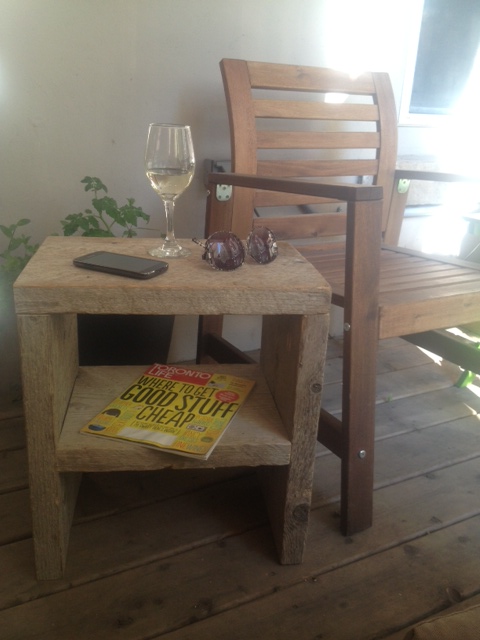
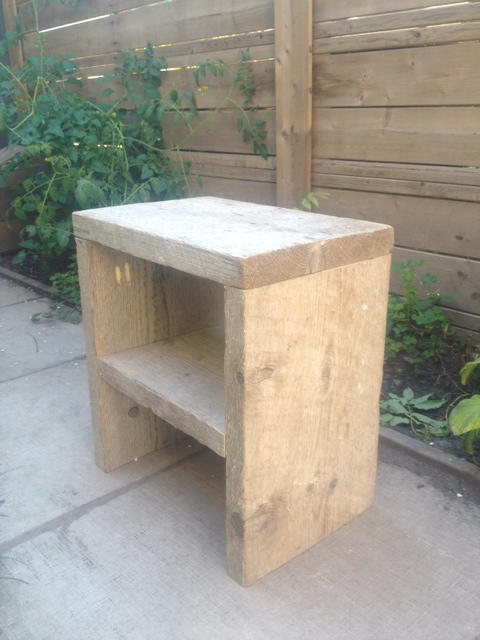
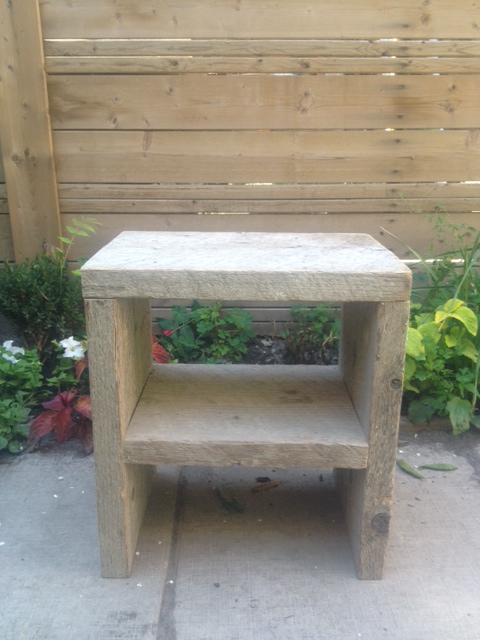
SOURCE LIST:
Buy List:
1 – 2×12 @ 8′ (Under the Bunkie)
12 – 2 1/2″ outdoor pocket hole screws (Lee Valley)
Cut List:
1 – 2×12 @ 17″ (top)
1 – 2×12 @ 13 1/4″ (shelf)
2 – 2×12 @ 17 3/8″ (sides)
Tools Used:
Miter saw
Drill
Kreg Jig
Measuring Tape
Difficulty Level (on a scale of 1-5):
Total Cost: $0 (booyakasha)
Pipe & Wood Table V2
We loved our DIY Pipe & Wood table and bench. However, we started to fall out of love with it after living with it for a few months. In order to get the table done on a budget & quick timeline we used framing grade spruce lumber from the big box store. Over time the wet wood warped, and our table was looking a bit topsy-turvy. Oops. The framing grade spruce also had rounded edges, which made for serious crumb catchers between the joints. Thirdly, we used Tung Oil to finish the table, and after a while, the tung oil started to smell, well, like spoiled oil. Nowhere in all my research did I find anyone saying tung oil would smell like butt after a few months. Lesson learned. (Although as a finish the tung oil was doing otherwise great, not a single water spot or mark on the table, if you can get past the butt smell.)
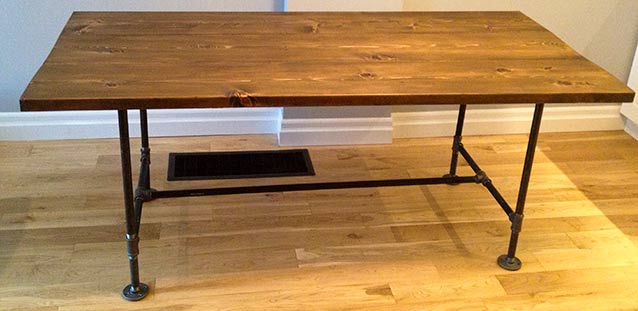
If you know me (and my neuroses) at all, you will know that I couldn’t just leave the table. I can live with dust bunnies rolling around the house becoming dust monsters, and I can live with dirty dishes in the sink, but a wonky smelly table? Not a hope.
So here it is kids:
DIY Pipe & Wood Table Version 2 (6’x 34 1/2″)
Lumber Buy List: (purchased from a local Home Hardware Building Center. Check your neighborhood to see if you have a Home Hardware Building Center or another lumber yard . They will carry a larger amount of lumber than the big box stores, at about the same prices.) If you’re in Toronto, try Downtown Lumber (a Home Hardware) or Central Fairbank Lumber.
3 – Kiln dried pine 2×12’s @ 6′ (square cut edges, not rounded ones)
1 – Kiln dried pine 2×2 @ 8′ (support pieces)
Cut List:
3 – 2×12’s @ 6′ (our lumber yard rough cut them to just over 6′, then we did nicer cuts with our sliding miter saw at home. If you do not have a sliding miter saw, or a circular saw that can cut through that thickness of wood, have your lumber yard cut it for you with their good saw, not their rough cut one.)
3 – 2×2’s @ 26″, cut to a 45 degree miter on either end.
Instructions:
Lay out your table top boards and decide which sides you want up. Make sure to flip the grain so that one board’s grain is up, and the next is down. When you have everything laid out (and square!) mark for Kreg pocket holes every 8″ or so on the bottom of 2 of your tabletop boards. Using the 1 1/2″ thick wood setting, drill your pocket holes. (see how to drill a Kreg pocket hole here.)
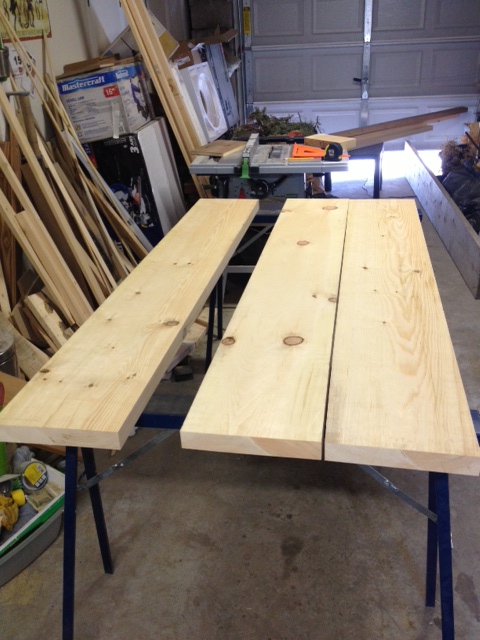
Attach your tabletop boards together with wood glue and 2 1/2″ Kreg Pocket Hole screws. Make sure your table is square before attaching the boards together. (You can check it with a square and by measuring corner to corner diagonally. If both sides are the same, your table is square.) Wipe off any excess glue that may have squeezed up between boards with a wet rag before it dries.
Once glued and screwed, attach the support pieces. We put one in the middle, and two right behind where our pipe legs would go. The ends are cut to a 45 so that its looks nicer, and you’ll be less likely to whack your knee off it later. We used some 2 1/2″ screws to attach the supports, making sure we got at least 2 screws into each board. These support pieces will try to keep your table from warping. Remember wood is a living organism, and changes during high & low humidity and heat. So you can never guarantee your wood will stay exactly the same. (That’s why you leave an expansion joint on your hardwood floors, or else they might buckle.)
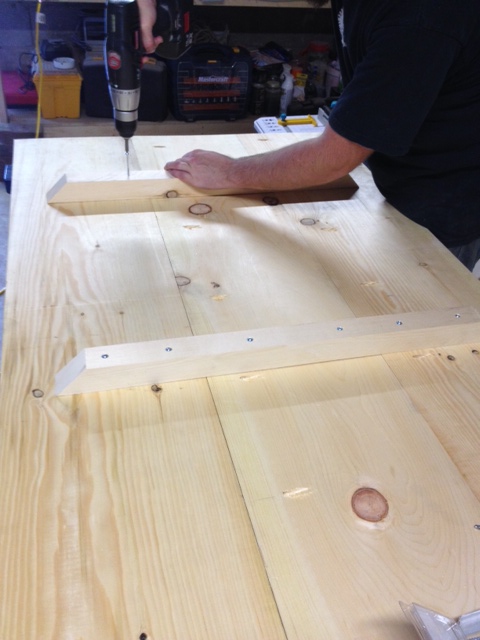
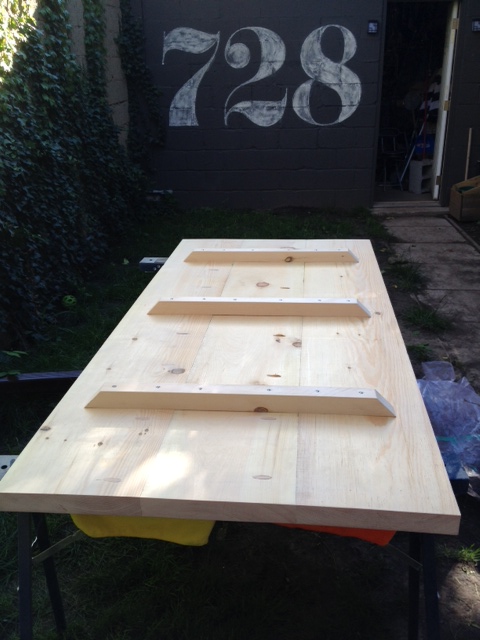
We also filled the pocket holes with Kreg wood plugs. You wouldn’t see the holes, but if you ran your hand along the underside of the table you would feel them. They also might catch on pants or stockings. The Kreg plugs are easy to use. A bit of wood glue and careful placement and they were done. After the glue dried we gave them a sand to ensure everything was nice and smooth.
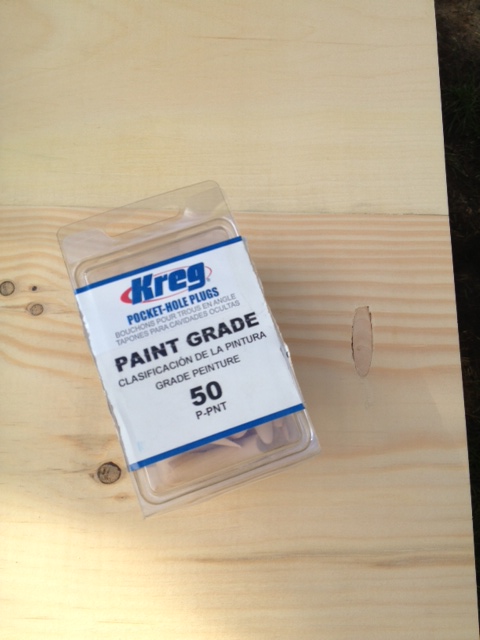
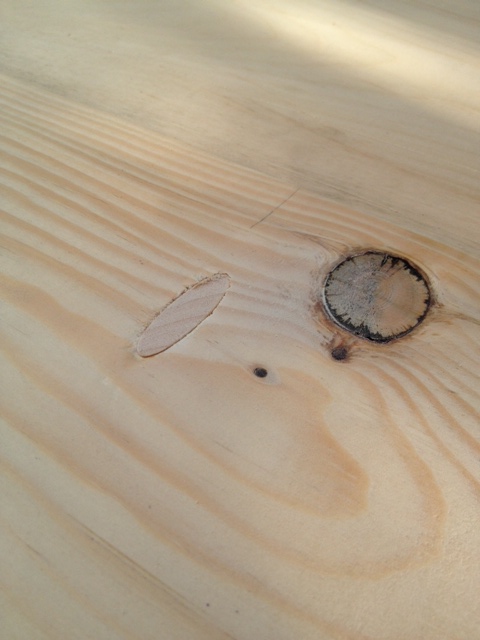
Now its time to sand. I like to sand outside in the summer, so out the table went. We sanded away, then I stained the table and royally screwed it up. OOPS. Time to fix my mistake, and try again.
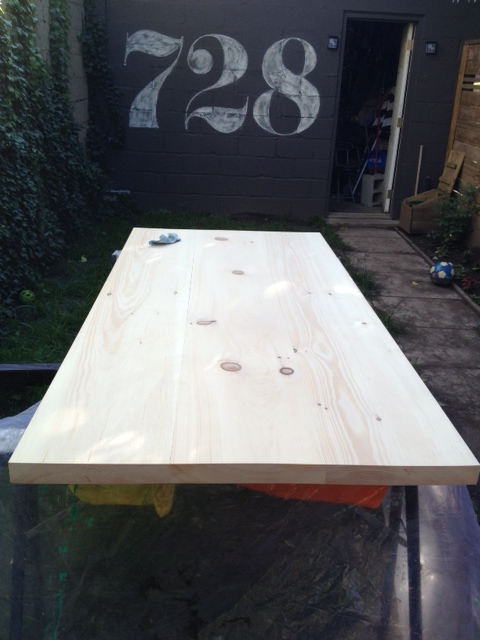
After the sanding came two coats of Varathane Chocolate Stain (check out my finishing post to see all my steps in sanding, wood conditioning & staining.)
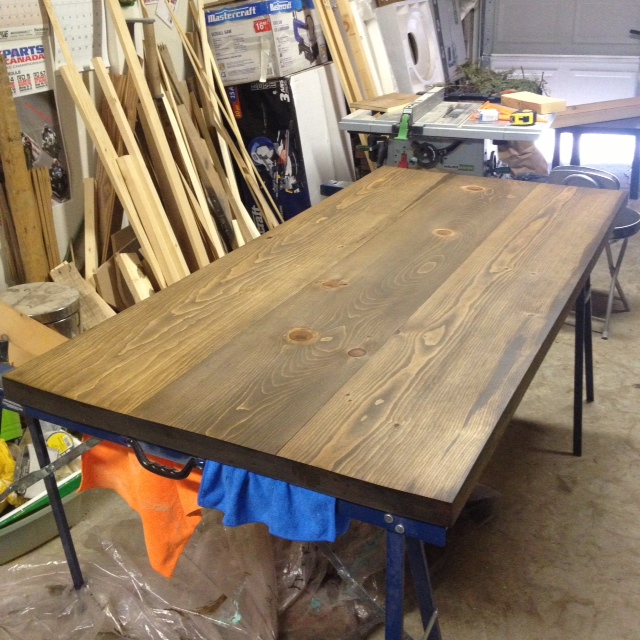
I can tend to get a wee bit anal retentive, so when it came to polyurethaning the table, I had to stop myself at 6 coats. Any more would be a bit cray cray. Realistically as long as you have at least three coats, you should be good.
Now to re-attach the legs from the old table. A bit of measuring to make sure its centered, and a few screws and we’ve got legs people.
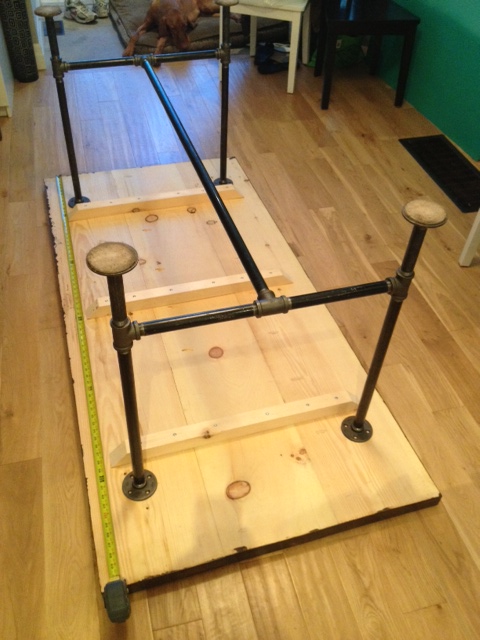
Want to see what it looks like all finished?! (ignore my terrible lighting, the dining room is impossible to shoot in.)
Dum da da daaaaaa
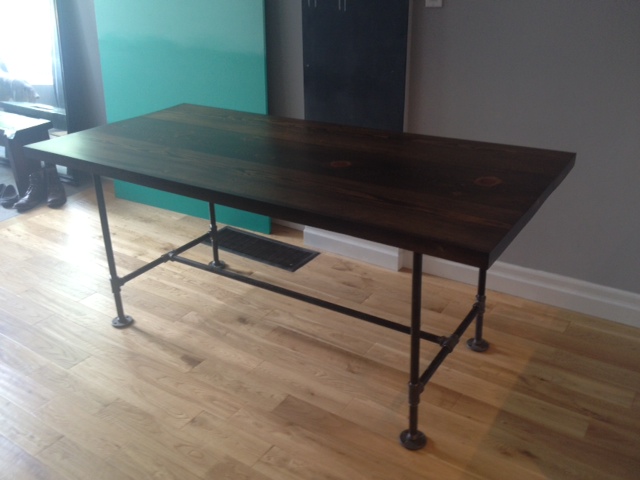
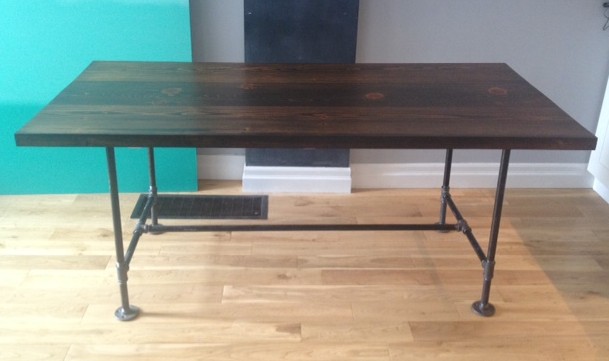
***UPDATE*** We also made a new bench to go along with the table. Check it out here.

SOURCE LIST:
Materials & Cut List:
(see above)
Tools Used:
Miter saw
Drill
Kreg Jig
Orbital sander
Measuring Tape
Difficulty Level (on a scale of 1-5):
Total Cost: $100 (for the new wood, we already owned the pipe, stain & poly)
Quick no Plan Project: Beer Can Carrier
Last weekend while Kristen was sanding a new project and I had little to do. Sure I could have helped. But why not whip together a quick project while she did all the boring work?
I have seen many beer/can carriers on the internet and decided to give it a try myself.
I started by measuring a can and adding some inches to the height to give some room for a handle (9 inches tall) and measured two cans beside each other for the width (giving a little breathing room for easy removal of frosty brews it came to 5 1/2 inches). Then I used a combination square to add 45 degree corners to the template (the flat top section is 1 3/8 inches).
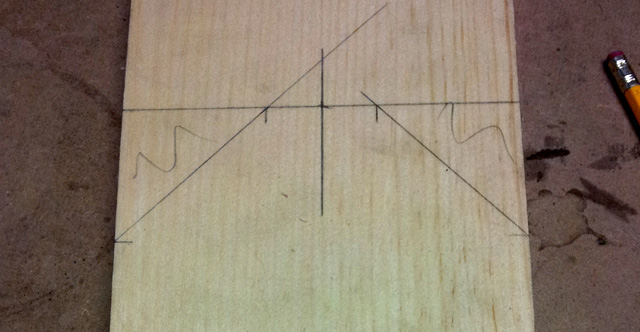
After cutting out the first side of the carrier with the miter saw I decided I was happy with the size and traced the outline to the 2nd side.
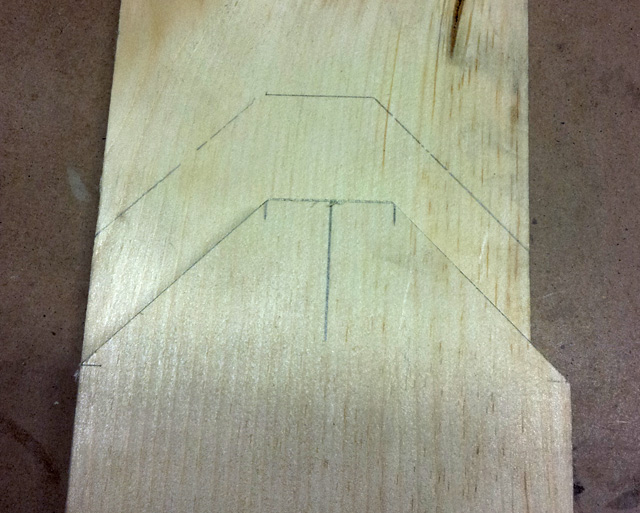
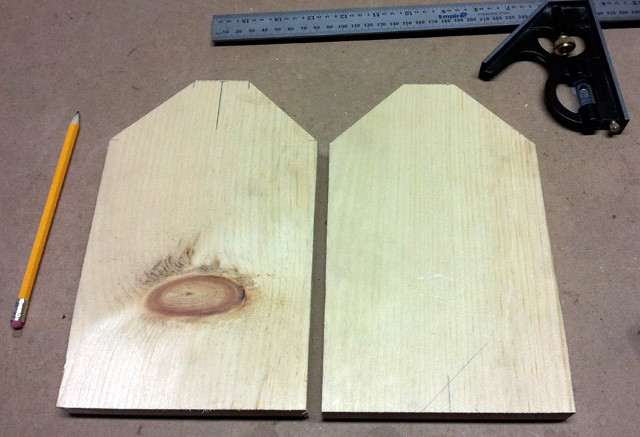
I measured and drilled a 3/4 inch hole in each side for the handle to pass though.
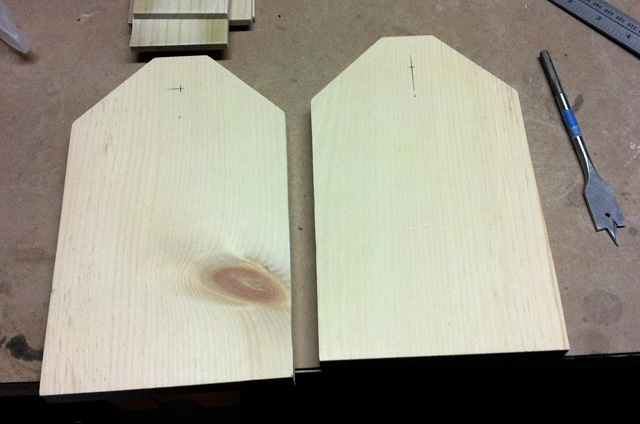
DIY Tip: place a scrap board beneath your piece to stop tearout when drilling holes that will be seen or are large
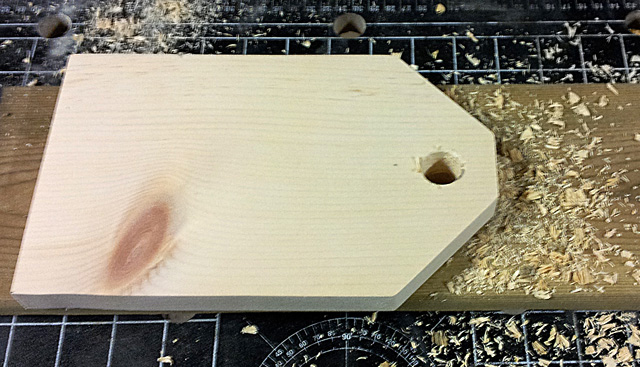
I then lined up three cans and and measured their width and found that with a little breathing room 9 1/2 inches suited three cans quite well.
I found some poplar that was laying around the garage and cut 4 strips to 9 1/2 inches long and ripped two of them down to 2 5/8 inches to make the bottom of the carrier with a little gap on either side for the escape of any condensation that may build up and drip down the sides of my nectar vessels during transport.
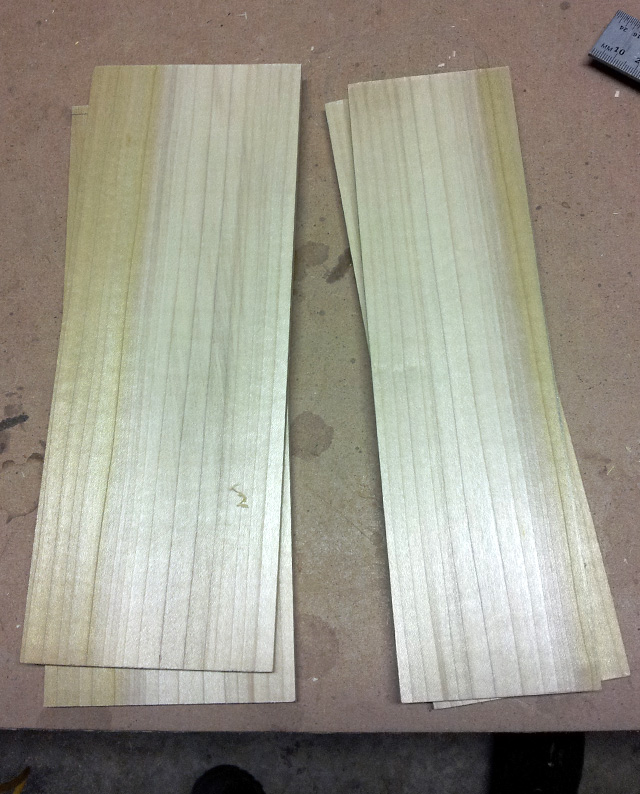
After all the pieces were cut they were sanded down to 220 grit and I attached them all together using some black finishing nails that were left over from ages ago when we made the Liquor Cabinet. Leaving a gap between the sides and the bottom (more condensation relief).
I then cut the handle (some 3/4 inch dowel left over from a project you’ll see in the future) to size leaving a little room for it to poke out just for looks and inserted it in to one side of the carrier. I then coated the inside end and the outside end of the handle with glue and slid the entire thing in to place so that no glue got where it shouldn’t be. (Wiping up any excess that squidged out.)
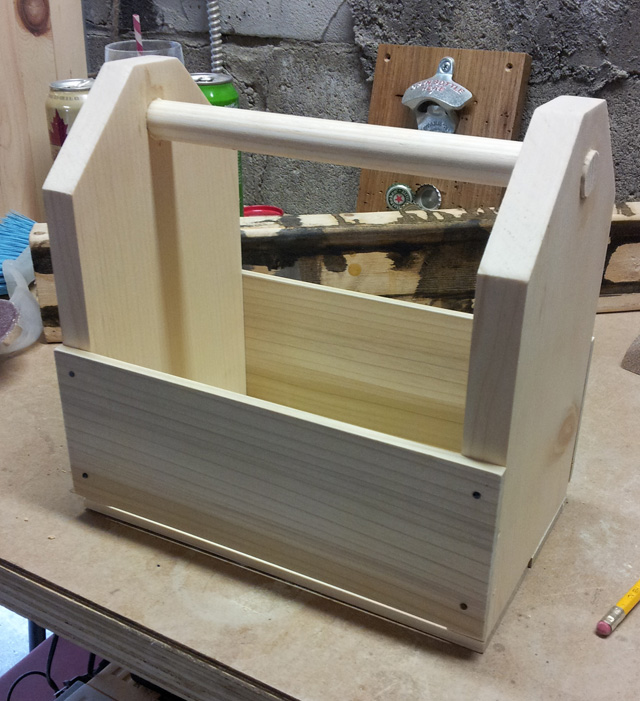
I picked a random jar of stain (Minwax Weathered Oak) and set to staining. Then I hated the stain.
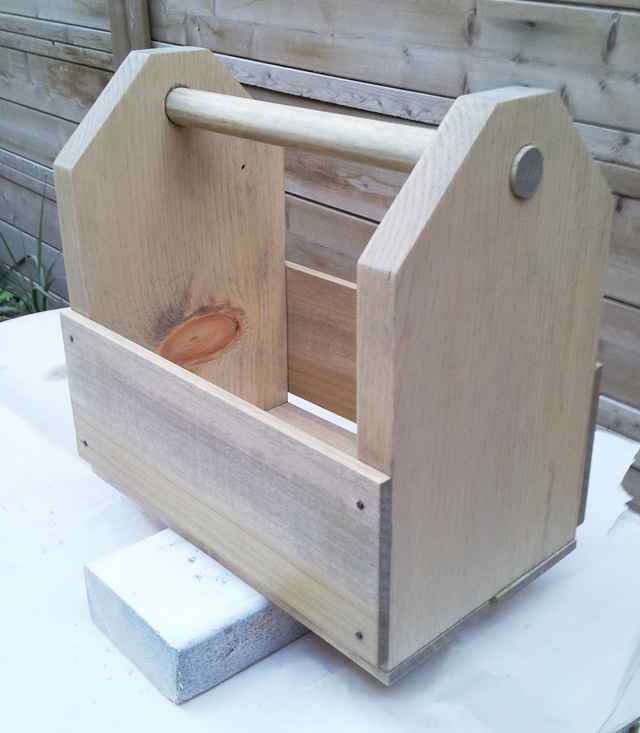
So I restained it darker using Minwax Jacobean.
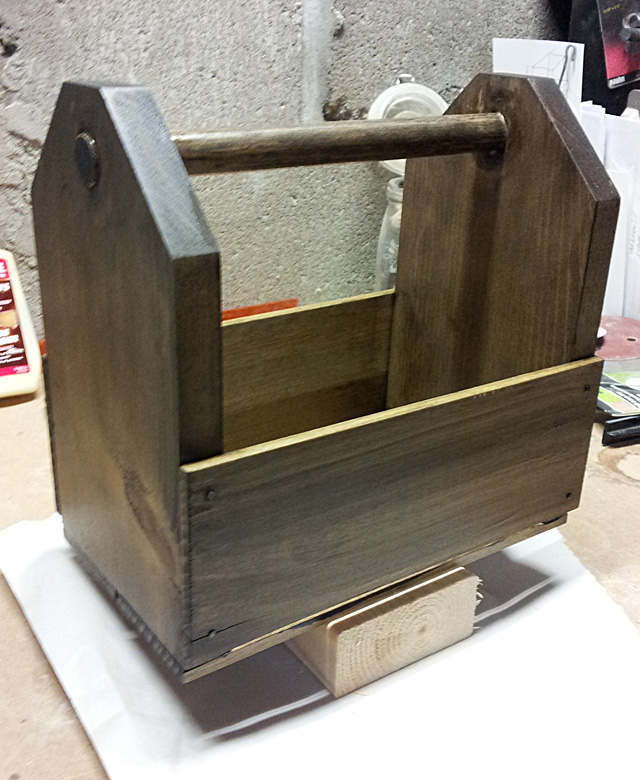
Happy with the stain I set to four coats of Varathane Oil Modified Polyurethane in Satin finish. Using the process outlined in the finishing post.
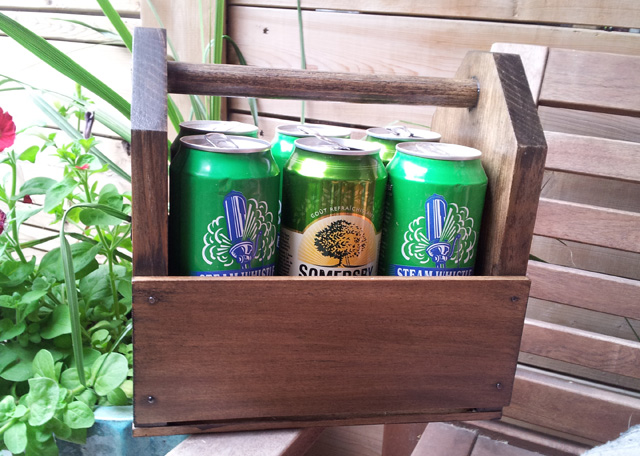
In all I think this probably took about an hour and a half including stain and finishing. The entire build only took about 45 minutes and was a great way to get me out of sanding other projects. AND now we have a great way to carry our Friday Libations out to the patio (or the park shhhhh).
SOURCE LIST:
Materials:
Scrap Pine (1×6 x 2′)
Scrap Poplar (1/4″)
Scrap Dowel (3/4″)
Scrap Finishing Nails
Cut List:
2 – 9″x5 3/4″ – 1″ thick Pine
2 – 4″x 9 1/2″ – 1/4″ thick poplar (sides)
2 – 2 5/8″ x 9 1/2″ – 1/4″ thick poplar (bottom)
1 – 9 1/2″ dowel (handle)
Tools Used:
Miter saw
Combination Square
Drill
3/4″ Spade Drill Bit
Orbital sander
Measuring Tape
Difficulty Level (on a scale of 1-5):
Total Cost: $0!!!
Blogaversary – The Truth
So its official, we’ve been blogging for a whole year and over 200 posts! I know, time flies! Our Blogaversary also happens to fall on our summer vacation. So although we’ll be taking a break from the blog for a week of sun and fun, we will have a few new things to share with you.
First up, THE TRUTH!
Facebook, Twitter, Instagram and blogs skew our perspective of other peoples lives. You don’t see piles of laundry, their kids screaming, couples having arguments, bills, stress and chaos. The internet is like a magazine, only the most flattering parts of something are shown.
I know you see El Granto & I working away on projects every weekend, but here’s the truth. It doesn’t always go as planned, sometimes we screw up, and big. When were in the middle of a project, our house is in chaos, the laundry un-done, a dust bunny rolling down the hallway gathering size, and sometimes we have cereal for dinner.
So here is a post about the truth. The good, the bad and the ugly, but all of it true.
- Every single photo on the blog is taken with a cell phone. When we started the blog, I didn’t want to drag out our DSLR for every photo. I didn’t want to shoot raw, process, retouch and re-size. The blog is a hobby, and as such, it needed to not take up all of our time to maintain. So we shoot every photo on my iPhone, export it as a medium res image, and upload. No color correcting, no retouching. What you see is what you get.
- I write all my blog posts on the bus. I have a long commute, and between my 9-5 day job, commute, life & our projects it didn’t leave much time for blog writing. I would rather spend my evenings cuddling on the sofa with husband and puppy that stuck in the office writing. So I have found time during my commute to write my posts. I write everything as a draft in my email (again on my phone!), then when I’m at a computer I copy and paste and upload the photos.
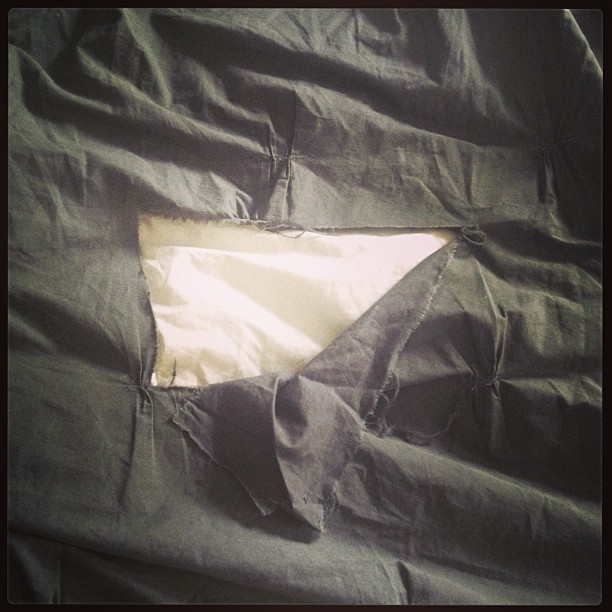
whats that? oh you know, the dog ripping a hole in our $150 douvet cover - We argue. We are both very stubborn and passionate people. We have opinions and like to do things our way. We argue over how to do projects, how much money to spend on them, and when things go wrong we can be not so nice to each other. I think the key to out working together is to know our strengths, to listen to eachother and to take a break when things aren’t working right. Usually a few minutes away (most likely with a drink on the deck and a game of fetch with the dog) and we are relaxed to give it another go.
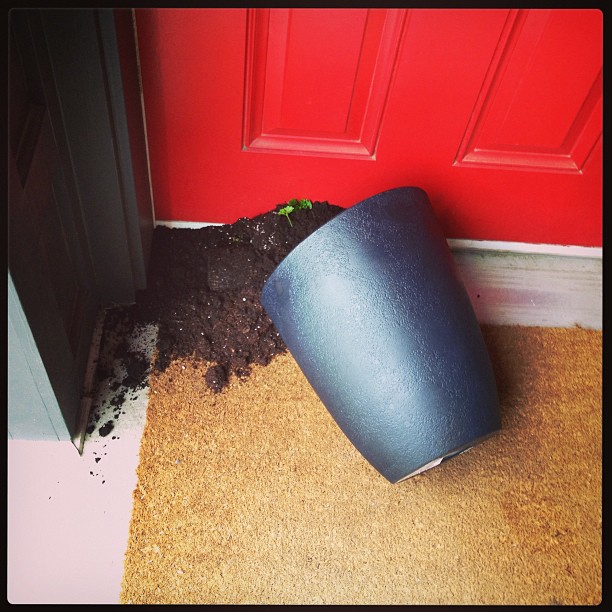
- DIYing calms and relaxes me. I know that sounds crazy, as normally DIYing stresses people out. They do call it Divorce Dust after all. However building takes me to my happy place. If I could quit my day job and build things all day I would be happier than a pig in s#!t.
- I dream about reno projects. I often have trouble falling asleep at night, and to calm my brain I think about projects I’d like to do, and how I’d do them. I think planning is half the fun in a project (nerd alert).
- I am the spastic one, and El Granto is the calm level headed one. I have crazy ideas, and he brings me down to earth and keeps me sane. We are both creative types and feed off eachothers ideas. One of us can have a great idea and then the other one will chime in to make it even better. This is both a good and a bad thing, as it usually means more work or more money to spend on a project!
- El Granto built and maintains the site. When I said I wanted a blog, he set it up on a site we already had, and gave me one month to blog. He promised if I stuck with it, he’d give me my own domain. Well one month and 19 posts later, he realized that I wasn’t joking, and really wanted to do this. So that day he signed me up for a new domain, and www.storefrontlife.com was born.
- Ever wonder what we do for (real) jobs? I work in the photography industry, and El Granto is a web developer.
- A lot of the time we have no idea what we’re doing. We research things and watch YouTube videos like the rest of you. We’re not experts, and a lot of the time we’re just winging it. Most importantly we read the instructions. Most of the time there’s an expert telling you EXACTLY how to do something, you just have to follow the instructions.

Yep, that’s a burn in the shape of a comma, forever scarred into my arm - I use all the tools, and pull my weight in projects. Ours isn’t a house of “honey-do lists”. Everything is a group effort, and each of us pulls our weight in projects. We both have strengths and weaknesses, and things we like to do more than others. For instance, I usually let El Granto do most of the drilling, as for the life of me I cant hold a drill straight. I also am not the biggest fan of the table saw, and usually let El Granto do most of the cutting on it. El Granto hates sanding (I could probably trade him bathroom cleaning duty for sanding) but I don’t mind it that much, so I usually sand while he continues to build. However, I love the miter saw, and my anal retentiveness usually has me doing the measuring and finishing cuts.
- We have not made a penny off the blog, and our intention was never for this blog to make any money. We were doing the projects and sharing them with friends and family on Facebook already, and thought maybe someone else out here would like to hear about them. We also have went a year without ads or sponsors. That’s not to say that we wont consider that in the future (cause hey, this blog does cost $ to run!) but we want to share what we do, and hope you get some inspiration out of it!
So that’s us, in all our flawed glory. Thanks for spending the time with us for the last year, and hopefully we can get into some more fun in the years to come. Ohh snap, sh$t just got sentimental.
Playing Dress-Up
I know you usually see me wielding a drill, or covered in sawdust, but underneath all the paint & polyurethane, I am still a girl.
Wood Finishing
***Happy Canada Day to all my Canadian Readers!***
When woodworking, the cutting, gluing and screwing is only half the job. The finishing is just as important (if not more so). It’s also where you can make or break the project.
Yesterday we were working on a project in the garage and a visiting neighbor asked about our finishing techniques. If he was interested, I thought some of you may be as well.
So here it is, Kristen’s (not so expert) wood finishing techniques.
STEP 1. Sand, sand and then SAND SOME MORE!

Sanding is a tedious but incredibly important step. If your wood is quite rough or has a finish that needs to be removed, I like to start with an 80 grit sandpaper, any wood that’s in good shape, I start with a 100 grit. We have both palm sanders and an orbital sander. I find the orbital does a quicker job (and its easier to change the sanding pads),and it is my preferred sander. Set up a work table in a well ventilated area and/or wear a breathing mask. Inhaling saw dust isn’t fun. It will leave your nose stuffy and your eyes scratchy. Some woods are poisonous too so make sure you know what you’re working with and it’s toxicity.
Start sanding your surface evenly with the grain, ensuring you do not press down on your sander (or it will cut scratches and grooves into your wood, which will show when you stain.) Sand with your first grit of sandpaper until your whole surface is evenly sanded, and you have removed any major imperfections. Then step up to your next grit (80, 100, 150, 220) until you reach 220 grit. If your sandpaper gets clogged, or looses some of its roughness, switch it up for a new piece. I like to sand everything up to 220 grit. It is worth the effort to have a perfectly smooth surface. Once you’ve sanded your whole project with 220 take a good look and make sure there aren’t any scratches or little swirly marks from your sander. If there are, make sure do go back and sand them before moving on. Do you have any end grain visible on your project? If so, I recommend sanding that to 320 grit. End grain sucks in stain like crazy, so sanding it to a higher grit will make it soak in less stain.
When you’re done sanding, rid your project of saw dust with a clean dry rag.
STEP 2. Staining

Now that you’ve spent a bucket of time sanding, you really want your stain to look nice, right? That’s why I always use wood conditioner on softwoods (pine, fir, cedar, spruce etc.) What is wood conditioner? It is like primer for wood, it penetrates the wood and preps it for stain. Essentially it makes it a bit harder for the stain to soak in to the wood. If you don’t wood condition the soft wood can absorb a lot of stain, quick, and become blotchy. Wood conditioner ensures it goes on nice and evenly.
So after your wood is sanded, apply an even coat of wood conditioner with a brush. I like to use foam brushes from the dollar store. They work great, are inexpensive, and you don’t have to worry about washing them. Wood conditioner is very runny, and you don’t need a lot, just get your wood wet. You will notice your wood darken a bit, that’s fine, just make sure you get even coverage. You also don’t need to pour it on, just one even coat. After you’re done let it soak in for a half an hour and all your wood conditioner should be soaked in. If it isn’t, wipe any excess off with a clean rag.
Now its time to stain. Give your stain a good stir with a stir stick (again I get a bag at the dollar store). There is usually a bunch of stain sludge at the bottom of the jar, make sure to give it a good stir. Apply your stain evenly with a foam brush. You don’t need a lot, just make sure you get even coverage, with a little pooling on the surface. Cover your whole project evenly. Let it sit 5-10 minutes, and then remove with a clean rag. I like to use Shop Rag (the blue (expensive) heavy duty paper towel at the hardware store). I also like to wear latex gloves when working with dark stain. You want to wipe the wood with the grain, removing any excess stain. You will need to swap out your dirty rags with clean ones and keep going over your work until all the excess stain is removed and everything is even and pretty.
Leave your stain to dry for a day, then come back and give it a second coat. Really, don’t argue with me. One coat always looks okay, but two coats always looks BETTER. It doesn’t drastically change the stain color, but it does richen it. Makes the darks darker, and brings out more contrast. Just believe me, and do that second coat! You’ll thank me later.
STEP 3. Protect it!

There are lots of different finishes for woodworking, and I could write a ginormous post on all the options. However for the sake of your sanity, I will cover one technique here; Polyurethane. My favorite poly at the moment is Minwax Oil Modified polyurethane. It acts like an oil based, but cleans up like a water based and has a re-coat time of 2 hours. Woot woot. Now that you’re project is all stained pretty like, make sure its free from dust, dirt and debris, and that you have a good place to poly it that is nice and clean, and not too hot or too cold. I actually like to poly in my diningroom as strange as it may sound, but its free of dust and is climate controlled.
Now that your surface is prepped, gently stir your poly. DO NOT SHAKE IT. Bubbles are your enemy, and you need to do everything to keep them away from your project. So stir, not shake. Once your poly is mixed up, use a clean foam brush (the larger the better, but make sure it fits into your can.) Apply the poly in a light even coat with the grain. Work quickly, but gently as to not make bubbles. Once you have laid on your poly, leave it be. Don’t go back over it, it starts to level out and dry almost instantly, and back brushing it even a few minutes later can muck it up. So put it on and leave it alone. Don’t even look at it. Also be careful with the poly you will see drips, so don’t load up your brush too much. I like to get the first half inch of the brush wet, that’s it. Thin coat, light touch, no drops, no bubbles, and leave it be. Got it?
Once the whole thing is evenly covered. Walk away and leave it for two hours. Don’t watch it dry and freak out that its drying unevenly. Just leave, get a coffee, and come back.
Two hours later and you’re ready for your second coat. You run your hand over the surface and freak out because its all rough again! What about all your work sanding?! DOESN’T IT KNOW HOW MUCH TIME I SPENT SANDING?! Don’t worry, this is normal. Polying raises the grain of the wood. It will only take a few minutes to fix. Grab a piece of extra fine sandpaper. I like 320. GENTLY sand the surface by hand, making sure not to sand all the way through your poly (just barely touch the surface). It will start to turn a bit white, and make white dust, don’t worry that’s normal. When your whole surface is nice and smooth again, and you’ve sanded off any of the bubbles or drip marks, it’s time for a second coat. Grab a new piece of Shop Towel, and get it damp (not soaked, just damp) and wipe your whole surface, removing any of the sanding dust. You may need to get a second rag to give it another once over. Once its clean again, give it another light coat of poly. Let it dry, and then repeat the sanding (although this time it will be much less to sand) and follow up with a third coat of poly. Three coats is usually enough, but I like to give a couple extra to tabletops and other high traffic surfaces. After your last coat, let it dry for at least 24 hours before using.
You should have a perfectly smooth, professionally finished project that looks and feels amazing. Now pat yourself on the back, and have a drink. You deserve it.
